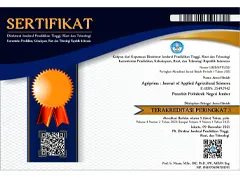Regenerasi Nilam Aceh ‘Sidikalang’ melalui Organogenesis tak Langsung dan Multiplikasi Tunas dalam Produksi Tanaman True-to-Types
DOI:
10.25047/agriprima.v6i1.447Downloads
Abstract
Nilam Aceh ‘Sidikalang’ (Acehnese Patchouli) merupakan salah satu anggota kelompok dari Lamiaceae, famili mint. Minyak aromatik yang biasa disebut juga dengan minyak patchouli dapat diproduksi dari daunnya, yang mana bernilai tinggi dalam industri parfum dan aromaterapi, karena wangi aromatik yang segar. Minyak patchouli juga memiliki variasi senyawa fitokimia yang memiliki efek terapeutik, seperti antimikroba, antidepresan, anti-inflamasi, dan antioksidan. Penelitian ini bertujuan untuk menentukan protocol yang efisien dan reprodusibel untuk refenerasi tak langsung dari eksplan daun dan banyak tunas dari eksplan nodus. Organogenesis tak langsung telah dilakukan menggunakan medium MS (Murashige-Skoog) dengan beberapa perlakuan, seperti NAA 0,5 mg/L + BAP 0,1 mg/L, NAA 1 mg/L + BAP 0,1 mg/L, dan NAA 1,5 mg/L + BAP 0,1 mg/L, sedangkan tunas majemuk yang dihasilkan dari eksplan nodus dikulturkan pada media MS dengan berbagai variasi konsentrasi BAP, yakni 0,5 mg/L, 1,0 mg/L, dan 1,5 mg/L kemudian, untuk tahap perakaran dari tunas, tunas akan dikulturkan pada media ½ MS tanpa Zat Pengatur Tumbuh (ZPT) dan media MS dengan beberapa perlakuan, yakni tanpa Zat Pengatur Tumbuh (ZPT), IBA (Indole-3-Butyric Acid) 0,5 mg/L, dan NAA (Naphthalene Acetic Acid) 0,5 mg/L. Selanjutnya, planlet yang dihasilkan dari tahap perakaran secara in vitro akan diaklimatisasi pada kombinasi tanah : kompos (1:1). Sebagai tambahan, tunas in vitro juga akan ditanam secara langsung sebagai stek tunas mikro pada kombinasi tanah : kompos (1:1). Perlakuan optimal untuk organogenesis tak langsung menggunakan media MS dengan NAA 1 mg/L + BAP 0,1 mg/L. Dalam perbanyakan tunas majemuk dari eksplan nodus, media MS dengan BAP 0,5 mg/L merupakan media optimum. Tunas yang dikulturkan pada media ½ MS untuk tahap perakaran, tumbuh membentuk planlet dengan morfologi akar normal. Secara keseluruhan, planlet nilam lebih cepat terbentuk melalui penanaman langsung stek tunas mikro pada kondisi ex vitro dibandingkan melalui tahap perakaran in vitro.
Keywords:
organogenesis tidak langsung, tunas majemuk dari eksplan nodus, Pogostemon cablin Benth.References
Abdulmalik, M., Usman, I., Olarewaju, J., & Aba, D. (2013). Effect of Naphthalene Acetic Acid (NAA) on In Vitro Rooting of Regenerated Microshoots of Groundnut (Arachis hypogaea L.). Bayero Journal of Pure and Applied Sciences, 5(2), 128–131. https://doi.org/10.4314/bajopas.v5i2.25 DOI: https://doi.org/10.4314/bajopas.v5i2.25
Akbar, M. A., Faridah, E., Indrioko, S., & Herawan, T. (2017). Induksi Tunas, Multiplikasi dan Perakaran Gyrinops versteegii (Gilg.) Domke secara In Vitro. Jurnal Pemuliaan Tanaman Hutan, 11 No. 1, 155–168. DOI: https://doi.org/10.20886/jpth.2017.11.1.155-158
George EF, Hall MA, Klerk GJD. (2008). Plant propagation by Tissue culture: Volume 1. The background. Third Edition, Springer Publisher: Dordrecht; London. DOI: https://doi.org/10.1007/978-1-4020-5005-3_1
Gil, C. S., Jung, H. Y., Lee, C., & Eom, S. H. (2020). Blue Light and NAA Treatment Significantly Improve Rooting on Single Leaf-Bud Cutting of Chrysanthemum via Upregulated Rooting-Related Genes. Scientia Horticulturae, 274(August), 109650. https://doi.org/10.1016/j.scienta.2020.109650 DOI: https://doi.org/10.1016/j.scienta.2020.109650
Hesami, M., & Daneshvar, M. H. (2018a). In Vitro Adventitious Shoot Regeneration Through Direct and Indirect Organogenesis from Seedling-Derived Hypocotyl Segments of Ficus religiosa L.: An Important Medicinal Plant. HortScience, 53(1), 55–61. https://doi.org/10.21273/HORTSCI12637-17 DOI: https://doi.org/10.21273/HORTSCI12637-17
Hesami, M., & Daneshvar, M. H. (2018b). Indirect Organogenesis Through Seedling-Derived Leaf Segments of Ficus Religiosa - A Multipurpose Woody Medicinal Plant. Journal of Crop Science and Biotechnology, 21(2), 129–136. https://doi.org/10.1007/s12892-018-0024-0 DOI: https://doi.org/10.1007/s12892-018-0024-0
Ipekci, Z., & Gozukirmizi, N. (2004). Indirect Somatic Embryogenesis and Plant Regeneration from Leaf and Internode Explants of Paulownia elongata (pp. 341–345). DOI: https://doi.org/10.1007/s11240-003-4632-7
Islam, A. T. M. R., & Alam, M. F. (2018). In Vitro Callus Induction and Indirect Organogenesis of Mentha piperita (L.) - An Aromatic Medicinal Plant. GSC Biological and Pharmaceutical Sciences, 4(3), 049–060. https://doi.org/10.30574/gscbps.2018.4.3.0078 DOI: https://doi.org/10.30574/gscbps.2018.4.3.0078
Jin, H., Deng, Z. C., & He, H. (2014). Effect of Explant Types and Plant Growth Regulators on Direct Regeneration in Medicinal Plant Pogostemon cablin. Plant OMICS, 7(5), 322–327.
Kusuma, H. S., & Mahfud, M. (2017). Microwave Hydrodistillation for Extraction of Essential Oil from Pogostemon cablin Benth: Analysis and Modelling of Extraction Kinetics. Journal of Applied Research on Medicinal and Aromatic Plants, 4(April 2018), 46–54. https://doi.org/10.1016/j.jarmap.2016.08.001 DOI: https://doi.org/10.1016/j.jarmap.2016.08.001
Mayerni, R. (2020). The Direct Organogenesis in Local Clones of Patchouli Plant (Pogostemon cablin Benth.) In Vitro. JERAMI Indonesian Journal of Crop Science, 3(1), 16–19. https://doi.org/10.25077/jijcs.3.1.16-19.2020 DOI: https://doi.org/10.25077/jijcs.3.1.16-19.2020
Mulia, P. I., Nopsagiarti, T., & Andi, A. (2020). Respon Pertumbuhan Eksplan Tanaman Pisang (Musa sp.) Varietas Roti dengan Penambahan Ekstrak Kentang pada Media MS. Jurnal Green Swarnadwipa, 26(11), 272–282.
Nakasha, J. J., Sinniah, U. R., Kemat, N., & Mallappa, K. S. (2016). Induction, Subculture Cycle, and Regeneration of callus in Safed Musli (Chlorophytum borivilianum) using Different Types of Phytohormones. Pharmacognosy Magazine, 12(47), S460–S464. https://doi.org/10.4103/0973-1296.191457 DOI: https://doi.org/10.4103/0973-1296.191457
Nuryani, Y. (2006). Budidaya Tanaman Nilam. Balai Penelitian Tanaman Rempah Dan Aromatik.
Rahman, Z. A., Mohd Noor, E. S., Mat Ali, M. S., Mirad, R., & Othman, A. N. (2015). Micropropagation of a Valuable Medicinal Plant, Plectranthus amboinicus. American Journal of Plant Sciences, 06(08), 1091–1097. https://doi.org/10.4236/ajps.2015.68113 DOI: https://doi.org/10.4236/ajps.2015.68113
Rai, M. K., Akhtar, N., & Jaiswal, V. S. (2007). Somatic Embryogenesis and Plant Regeneration in Psidium guajava L. cv. Banarasi local. 113, 129–133. https://doi.org/10.1016/j.scienta.2007.02.010 DOI: https://doi.org/10.1016/j.scienta.2007.02.010
Rathore, M. S., Chikara, J., & Shekhawat, N. S. (2011). Plantlet Regeneration from Callus Cultures of Selected Genotype of Aloe vera L . — An Ancient Plant for Modern Herbal Industries. Applied Biochemistry and Biotechnology, 860–868. https://doi.org/10.1007/s12010-010-9090-1 DOI: https://doi.org/10.1007/s12010-010-9090-1
Review, L. W. A. (2020). In Vitro Propagation, Phytochemical and Neuropharmacological Profiles of Bacopa monnieri (L.) Wettst.: A Review.
Satish, L., Ceasar, S. A., Shilpha, J., Rency, A. S., Rathinapriya, P., & Ramesh, M. (2015). Direct Plant Regeneration from In Vitro-Derived Shoot Apical Meristems of Finger Millet (Eleusine coracana (L.) Gaertn.). In Vitro Cellular and Developmental Biology - Plant, 51(2), 192–200. https://doi.org/10.1007/s11627-015-9672-2 DOI: https://doi.org/10.1007/s11627-015-9672-2
Shekhawat, M. S., Kannan, N., Manokari, M., & Ravindran, C. P. (2015a). Enhanced Micropropagation Protocol of Morinda citrifolia L. Through Nodal Explants. Journal of Applied Research on Medicinal and Aromatic Plants, 2(4), 174–181. https://doi.org/10.1016/j.jarmap.2015.06.002 DOI: https://doi.org/10.1016/j.jarmap.2015.06.002
Shekhawat, M. S., Kannan, N., Manokari, M., & Ravindran, C. P. (2015b). In vitro Regeneration of Shoots and Ex Vitro Rooting of an Important Medicinal Plant Passiflora foetida L. Through Nodal Segment Cultures. Journal of Genetic Engineering and Biotechnology, 13(2), 209–214. https://doi.org/10.1016/j.jgeb.2015.08.002 DOI: https://doi.org/10.1016/j.jgeb.2015.08.002
Tuhuteru, S., & Hehanussa, M. L. (2012). Pertumbuhan dan Perkembangan Anggrek Dendrobium anosmum pada Media Kultur In Vitro dengan Beberapa Konsentrasi Air Kelapa. Agrologia, 1(1), 1–12. DOI: https://doi.org/10.30598/a.v1i1.293
van Beek, T. A., & Joulain, D. (2018). The Essential Oil of Patchouli, Pogostemon cablin: A Review. Flavour and Fragrance Journal, 33(1), 6–51. https://doi.org/10.1002/ffj.3418 DOI: https://doi.org/10.1002/ffj.3418
Yudhanto, A. S., & Wiendi, N. M. A. (2015). Pengaruh Pemberian Auksin (NAA) dengan Sitokinin (BAP, Kinetin dan 2ip) terhadap Daya Proliferasi Tanaman Kantong Semar (Nepenthes mirabilis) Secara In Vitro. Buletin Agrohorti, 3(3), 32. DOI: https://doi.org/10.29244/agrob.3.3.276-284
Zayova, E., Nedev, T., Petrova, D., Zhiponova, M., Kapchina, V., & Chaneva, G. (2020). Tissue Culture Applications of Artemisia annua L. Callus for Indirect Organogenesis and Production Phytochemical. Plant Tissue Culture and Biotechnology, 30(1), 97–106. https://doi.org/10.3329/ptcb.v30i1.47795 DOI: https://doi.org/10.3329/ptcb.v30i1.47795
License
Copyright (c) 2022 Natasha Florenika, Agnes Natalia Wijaya, Didik Puji Restanto, Poppy Hartatie Hardjo

This work is licensed under a Creative Commons Attribution-ShareAlike 4.0 International License.
You are free to:
- Share — copy and redistribute the material in any medium or format.
- Adapt — remix, transform, and build upon the material for any purpose, even commercially.
Under the following terms:
- Attribution — You must give appropriate credit, provide a link to the license, and indicate if changes were made. You may do so in any reasonable manner, but not in any way that suggests the licensor endorses you or your use.
- ShareAlike — If you remix, transform, or build upon the material, you must distribute your contributions under the same license as the original.
- No additional restrictions — You may not apply legal terms or technological measures that legally restrict others from doing anything the license permits.








